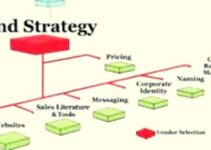Companies can apply advanced technological development to finding the customer location in marketing. Taking advantage of this technology would allow them to influence potential customers and become more visible online. Today, we’ll discuss what is location-based marketing (LBM); how it works, its benefits, types, and examples.
What is Location-Based Marketing?
LBM (location-based marketing) is a type of mobile app marketing that has increased significantly over time with the growing dominance of mobile devices. The MMA (mobile marketing association) outlines a campaign, service, or application comprising of using geographic location to deliver service and sending optimized messages. In simple words, it allows companies to find the location of the customer’s proximity to the retailer, and then send them targeted messages about products or services relevant to their location.
It is a form of adaptable marketing strategy that helps you to target precisely. It treats customers as a homogenous group; LBM follows specific cultural and personal characteristics.
Types of Location-Based Marketing
Some of the main types of LBM are as follows;
Geo Conquesting
Geo conquesting is a bit controversial technique and many people view it as unfair competition. It employs the location of data to discourage people from visiting the competitors. For instance, you’re walking into the Burget King branch, and you receive a notification from McDonald’s to change your mind about where you should buy.
Beaconing
Beaconing is a very important device comprising wi-fi and Bluetooth; it assists small and medium-sized businesses and companies to find customers and send them information relevant to the location of your business. Beacons transmit signals to the devices that would make the server transmit particular content like push notifications and emails.
Geofencing
Geofencing is the process of setting up a virtual perimeter around your location; people would receive notifications on their smartphones when they enter your virtual perimeter. Supermarkets and shopping malls send promotional messages to the customers on their smartphones when they enter your store.
Geofencing employs GPS technology to set up boundaries and virtual perimeters. In fact, it employs real-time location-based technology that allows marketers to send targeted ads.
Geotargeting
Geotargeting helps businesses and companies to send messages and notifications to customers in a specific area. It is a very popular method that you can do with Facebook and the Search Engine, and it sends targeted ads to the customers relevant to the location of customers.
Every electronic connection with the internet has a specific IP address and t employs the IP addresses of users in order to know your location. Personalization and accuracy of customers’ location would offer you a better user experience.
How Location-Based Marketing Works
Some of the main steps on how LBM works are as follows;
Traffic Flow
When you’re developing the LBM strategy, your focus should be on finding the location of high traffic area, it would allow you a lot of your target customers. You should select a location that has got high traffic in your area and develop a market campaign to approach them. For instance, you should think of any such event or festival that would bring you a lot of traffic like Black Friday.
Don’t Overdo it
When it comes to attracting traffic, the focus of some marketers is on quantity rather than quality. It may seem like an interesting and doable idea, but it is not. For instance, Neil polish is a good product, but sending push notifications won’t make any significant impact on your brand. Therefore, you should follow an intentional approach when and where you put ads.
Customer Service
Customers find the push notification annoying. You should keep in mind that customers don’t like bombarded notifications and your offer should attract the attention of customers. Your focus should be on offering a better customer experience.
Many customers choose whether or not they should buy products from you or not based on their purchasing experience; don’t forget to ask them about their shopping experience. It would help you to improve their customer experience based on feedback.
Benefits of Location-Based Marketing
Some of the main benefits of location-based marketing are as follows;
Data Collection
LBM allows you to gather data from your campaign after launching it in order to know the insight and behavior of customers while shopping. You can improve the effectiveness and optimize your campaign. While keeping in mind the advantages, LBM helps you to increase your sale and customer reach.
Lower Cost
If you compare the cost of LBM with its advantages, then it is very low, and it is free in many cases. In fact, Facebook offers you for free.
Higher Engagement
LBM strategy amplifies the engagement of your market campaign. With target market geographic segmentation, the ads campaign is much easier to conduct, and it amplifies your brand awareness.
Improving Customer Experience
By combining LBM with a better customer experience, you can make your customers visit your store repetitively. Your top priority should be establishing the loyalty and trust of customers, and you can do so with LBM strategies.
Knowing Customers
LBM strategy helps businesses and companies to connect with customers at a more personal level based on you data you receive from their mobile devices. Companies could use it to amplify their market reach.
Examples of Location-Based Marketing
Whole Food
Whole Food employs both geo-conquesting and geofencing strategies to amplify the conversion rate and the company’s market share. The supermarkets send encouraging promotional discount messages to the customers in the nearest grocery stores to change their minds and make them visit your store. The conversion rate of such a campaign is roundabout 4.69%.
Adidas
Adidas employs the LBM strategy in its search ads to motivate customers to visit the company’s nearest location point. Approximately one in every five people visits the Adidas store which amplifies the ROI roundabout by 680%.
Conclusion: What is Location-Based Marketing? Types, Benefits, Examples
After an in-depth study of what is location-based marketing (LBM); its types, how it works, its benefits, and examples; we have realized that LBM is a growing campaign strategy that businesses and companies employ. If you’re developing it for your company, then you should keep in mind the abovementioned tips and suggestions.

Ahsan Ali Shaw is an accomplished Business Writer, Analyst, and Public Speaker. Other than that, he’s a fun loving person.


